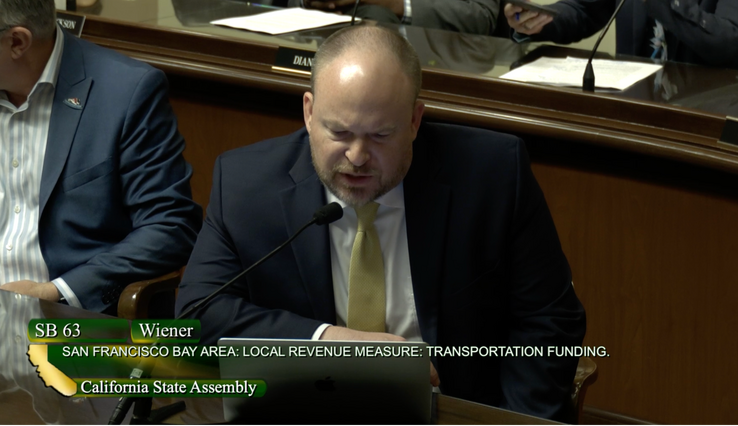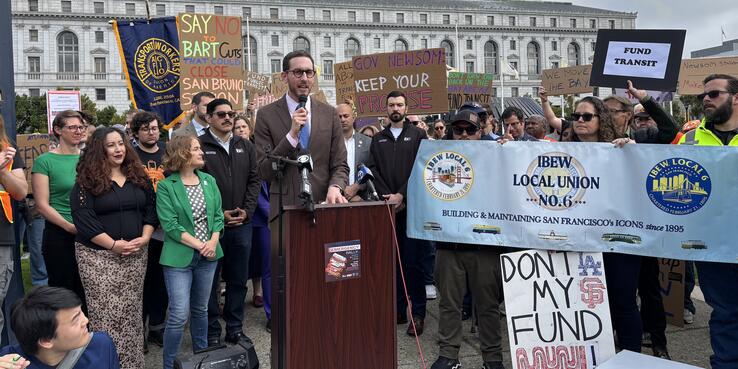The California Legislature’s 2025 session, which wrapped on September 13, was an extraordinarily important one for funding public transit in the Bay Area. SPUR has made securing transit funding a priority this year, and we have spent the last several weeks working intensively with legislators, local policymakers, government staff, and advocates to ensure that our transit priorities advance in Sacramento. The work is not done, but here’s an initial roundup of some of the key events and decisions of the last few weeks and SPUR’s role in them.
Securing Lifeline Loans to Keep the Bay Moving
Transit agencies and advocates have warned of a looming fiscal cliff for transit. BART, SF Muni, AC Transit, and Caltrain, which collectively carry more than 80% of all transit riders in the Bay Area, will all run out of operating funding by spring 2026, when federal and state relief funds will be exhausted. Senate Bill 63 (discussed below) provides a longer-term funding solution to the region’s challenges by authorizing a funding measure to go on the ballot in 2026. But even if successful, funds from such a measure wouldn’t flow to transit agencies until the middle of 2027, leaving a significant short-term funding gap. Throughout the 2025 legislative session, SPUR led a campaign to support a state budget request from senators Wiener and Arreguín for short-term funding to bridge that gap.
We mobilized local elected officials, business groups, and advocates to convey to legislators and decision-makers the importance of this funding and the risks posed by transit cuts to cost of living, quality of life, climate, air quality, and the regional economy. The effort paid off. In June, the Legislature and the Newsom administration committed to $750 million in loans for Bay Area transit operators to address near-term needs as part of a preliminary budget deal, deferring to the State Department of Finance to finalize the details with operators before the end of the legislative session.
As the session drew to a close, it became clear that crucial aspects of the deal remained unresolved and that the promised loans might not advance. SPUR activated our large coalition, which leapt into action and organized calls to the governor, put together a major rally on the steps of San Francisco City Hall, and raised the transit issue’s profile with the administration and in the media. As a result of our efforts, the administration reaffirmed its commitment to short-term support for Bay Area transit operations and agreed to extend the deadline for negotiating loan terms through fall 2025.
Authorizing a Regional Transit Funding Measure to Improve and Sustain Transit
At the same time that advocates and legislators were fighting for near-term “bridge” funding in the form of a state loan, SB 63 (Wiener, Arreguin), a bill that would enable a future Bay Area regional transit funding measure, was going through the final stages of negotiation in the legislature. SPUR was an early supporter of SB 63 and has worked with the bill’s authors, local elected officials, and public agency staff for months to shape the legislation in a way that would address transit’s fiscal needs while being viewed as fair and politically palatable across the region.
As approved by the legislature, SB 63 enables the formation of a regional transit district (governed by the Metropolitan Transportation Commission) with the authority to place a 14-year sales tax measure on the ballot in the Bay Area’s five southern counties (Alameda, Contra Costa, San Francisco, San Mateo, and Santa Clara). The bill also authorizes the measure to be placed on the ballot as a citizen initiative via signature gathering, a process that would lower the required vote threshold for tax measures in California, typically a two-thirds vote, to 50% plus one vote. The levy would be a full cent in San Francisco and a half cent in each of the four other counties, generating approximately $1 billion a year in new funds that would be spent exclusively on public transit. The bill’s expenditure plan carefully stipulates how funds must be spent, with specific percentages going to regional transit integration programs and individual transit operators. Any remaining funds would be “returned” to individual counties for their use on local transit needs.
SB 63 is a complex piece of legislation that required significant discussion and negotiation in the legislature, pushing final votes to the very end of the session. An outcome SPUR had worked to achieve came in early August: the legislation passed a key milestone when the Santa Clara Valley Transportation Authority in Santa Clara County and the San Mateo Transit District in San Mateo both voted to have their respective counties opt in to the bill. These votes cemented the measure as a truly “regional” effort covering all of the counties where major transit funding deficits — and service cuts — are expected. Discussions over specific accountability provisions and details of the bill continued up until its passage by the assembly late on September 12 and approval by the senate in the early hours of the morning on September 13.
Passage of SB 63 is a major milestone for SPUR. We have worked diligently over the past year to ensure that the Bay Area has the enabling legislation it needs to run a regional transit measure. We were one of the first entities to take a support position on the bill, and we served as a lead witness, providing testimony at both the Senate Revenue and Taxation and the Assembly Revenue and Taxation committees. More broadly, SPUR held the “big picture” to steer decision-makers toward compromise and collaboration, and we played an important role coordinating the many advocates and business and labor groups interested in tracking and shaping SB 63.

SPUR Senior Policy Advisor Sebastian Petty provides testimony to the California Assembly Transportation Committee on the importance of passing SB 63 to fund Bay Area transit. Image via California State Assembly
Reauthorizing the Cap-and-Invest Program — With Funding for Transit
On the last day of the 2025 session, the legislature advanced a package of bills reauthorizing and extending the state’s signature Cap-and-Trade (now known as Cap-and-Invest) Program through 2045. The climate policy puts a cap on emissions that industry may emit and allows companies to buy and sell emissions permits via an auction system that “prices” pollution. Revenues from the auction are used to fund the Greenhouse Gas Reduction Fund (GGRF), which in turn provides money to a variety of statutory and discretionary spending programs. Historically, the cap-and-trade auctions have generated up to a billion dollars a year in stable funding for transit capital projects (and some monies for transit service).
The reauthorization process was complex, involving discussions about reforming both the overall design of the permit market program and the distribution of the proceeds via the GGRF. In the context of a broad and varied advocacy landscape, SPUR chose to focus on the GGRF and its three transit and affordable housing funding programs, including the Transit and Intercity Rail Capital Program, the Low Carbon Transit Operations Program, and the Affordable Housing and Sustainable Communities program.
Our top priorities were to protect previously agreed-on transit relief funds, to maintain and expand the percentage of revenues available to transit and affordable housing in order to provide ongoing certainty, and to allow more of the transit funds to be used for transit service and maintenance. We also advocated for investments in the Bay Area’s rail system (sometimes referred to as the northern “bookend” of the state rail system) as a complement to increased funding for high-speed rail construction in the Central Valley.
The Cap-and-Invest Program reauthorization package that the state ultimately adopted substantially maintains funding for core transit and affordable housing programs; however, SPUR will continue to work on identifying and advocating for updates to the programs to meet changing needs.
SPUR will continue to focus on the critical issue of transit funding and, over the coming weeks, will have more to say about important bills for transit, including SB 71 and SB 79, which the legislature approved earlier in the 2025 session.
